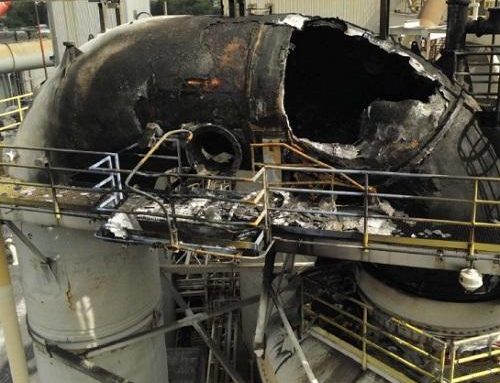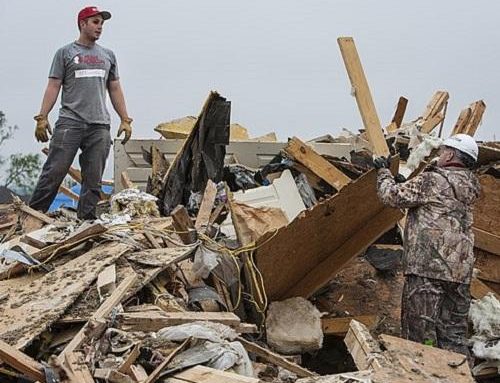Introduction
I have a personal connection to Ammonium Percholorate. I remember living near the site of the PEPCON explosion in Henderson, Nevada, and feeling the jarring explosion on May 4, 1988. It was a frightening experience that emphasized the dangers associated with volatile chemicals like ammonium perchlorate (AP). The PEPCON disaster claimed the lives of two individuals, injured hundreds more, and resulted in an estimated $100 million in damages. Investigations into the plant’s safety practices revealed deficiencies, leading to the implementation of new regulations and guidelines for handling and storing ammonium perchlorate. As we continue to rely on chemicals like AP for various applications, it is crucial that we remain vigilant in maintaining the highest safety standards to protect both workers and the surrounding communities.
What is Ammonium Perchlorate?
Ammonium perchlorate (AP) is a colorless or white inorganic compound with the formula NH4ClO4, known for being a powerful oxidizer. It is a white crystalline substance that is stable in its pure form at ordinary temperatures but decomposes at 150°C or above. When mixed with finely divided organic materials, AP becomes explosive and exhibits similar shock sensitivity to picric acid (Class A explosive). Sensitivity to shock and friction may increase when contaminated with impurities such as sulfur, powdered metals, and carbonaceous materials, and AP may explode when involved in a fire. It is commonly used in rocket propellants, specifically ammonium perchlorate composite propellants, and has a history of application in space launch, military, and hobby rockets. AP can also be found in some fireworks and breakable epoxy adhesives. Produced through the reaction between ammonia and perchloric acid or by salt metathesis, AP decomposes upon mild heating, with strong heating potentially leading to explosions. It is classified as a Class 4 oxidizer for particle sizes over 15 micrometers and an explosive for sizes under 15 micrometers.
Hazard Summary
This white, sand-like powder might seem harmless, but it’s actually a highly reactive chemical and a dangerous explosion hazard.
When you breathe it in, ammonium perchlorate can irritate your nose and throat, causing coughing and wheezing. If you get it on your skin or in your eyes, it can cause irritation. High levels of exposure can even mess with your blood’s ability to carry oxygen, leading to headaches, fatigue, dizziness, and a blue tint on your skin and lips, which is called methemoglobinemia. If it gets really bad, you could have trouble breathing, collapse, or even die.
But that’s not all – ammonium perchlorate can also affect your kidneys. You’ll find this chemical used in analytical chemistry, etching and engraving, animal fattening, and, believe it or not, explosives.
Ammonium perchlorate is on the Hazardous Substance List because it’s cited by the DOT and NFPA. It’s also on the Special Health Hazard Substance List because it’s reactive. So, if you ever come across this stuff, make sure you handle it with care and follow proper safety guidelines. Stay safe out there, folks!
Now, let’s talk about workplace safety tips for dealing with ammonium perchlorate.
Workplace Exposure Limits
There aren’t any established occupational exposure limits for this substance, but that doesn’t mean it’s harmless. You should always follow safe work practices.
Ways of Reducing Exposure
To reduce exposure, try enclosing operations and using local exhaust ventilation. If that’s not possible, make sure you wear a respirator. Protective work clothing is also essential. After you’ve been exposed to ammonium perchlorate, wash up thoroughly, and make sure hazard and warning information is posted in the work area. Keep your team informed about the health and safety risks associated with this chemical.
Health Hazard Information
As for health hazards, short-term exposure to ammonium perchlorate can cause skin and eye irritation, as well as coughing and wheezing from breathing it in.
Acute Health Effects
The following acute (short-term) health effects may occur immediately or shortly after exposure to Ammonium Perchlorate:
- Contact can irritate the skin and eyes.
- Breathing Ammonium Perchlorate can irritate the nose and throat causing coughing and wheezing.
- High levels can interfere with the ability of the blood to carry Oxygen causing headache, fatigue, dizziness, and a blue color to the skin and lips (methemoglobinemia).
- Higher levels can cause trouble breathing, collapse and even death.
Chronic Health Effects
The following chronic (long-term) health effects can occur at some time after exposure to Ammonium Perchlorate and can last for months or years: Cancer Hazard
- Chronic exposure to perchlorates, even in low concentrations, has been shown to cause various thyroid problems, as it is taken up in place of iodine.
- According to the information presently available to the New Jersey Department of Health and Senior Services, Ammonium Perchlorate has not been tested for its ability to cause cancer in animals.
Other Long-Term Effects
- Ammonium Perchlorate may affect the kidneys.
Although the cancer-causing potential of ammonium perchlorate hasn’t been tested in animals, it’s still essential to take all necessary precautions.
Workplace Controls and Practices
Remember, if you can’t swap out a hazardous substance for something less toxic, ENGINEERING CONTROLS are your best bet for minimizing exposure. Enclosing operations or using local exhaust ventilation right at the source of chemical release is the most effective protection. Isolation of operations can also help. Relying on respirators or other protective gear isn’t as good, but sometimes it’s all you’ve got.
When assessing your workplace’s controls, think about:
(1) how dangerous the substance is
(2) the amount of the substance released in the workplace, and
(3) whether harmful contact with skin or eyes is possible.
Make sure you’ve got special controls in place for highly toxic chemicals or when significant exposure to skin, eyes, or lungs is a risk.
Here are some other control recommendations:
- If you can, automatically transfer ammonium perchlorate from storage containers to process containers.
- Before entering a confined space where ammonium perchlorate might be present, check that there’s no explosive concentration.
Good WORK PRACTICES can also help lower exposure risks.
Keep these recommendations in mind:
- If your clothing gets contaminated with ammonium perchlorate, change into clean clothes right away.
- Don’t bring contaminated work clothes home, or your family members could be exposed.
- Make sure the people laundering contaminated work clothes know about the hazards of ammonium perchlorate exposure.
- Have eye wash stations close by in the work area for emergencies.
- If skin exposure is possible, provide emergency shower facilities.
- If you come into contact with ammonium perchlorate, wash or shower immediately to remove the chemical. At the end of your shift, wash any body areas that might have touched ammonium perchlorate, even if you’re not sure.
- Avoid eating, smoking, or drinking in areas where ammonium perchlorate is handled, processed, or stored, because you could accidentally ingest the chemical. Wash your hands thoroughly before eating, drinking, smoking, or using the bathroom.
- To minimize dust during cleanup, use a vacuum or wet method. DON’T DRY SWEEP.
Personal Protective Equipment
PPE is necessary for certain tasks like outdoor work, occasional jobs, confined space entry, or while workplace controls are being set up.
OSHA 1910.132 mandates that employers figure out the right PPE for each hazard and train employees on proper use and when to wear protective gear.
Keep in mind, these recommendations are only guidelines and might not cover every situation.
Clothing
- Steer clear of skin contact with ammonium perchlorate. Wear protective gloves and clothing. Consult safety equipment suppliers or manufacturers for advice on the best glove and clothing materials for your operation.
- Make sure protective clothing (suits, gloves, footwear, headgear) is clean, available daily, and put on before starting work.
Eye Protection
- Use impact-resistant eye protection with side shields or goggles.
- When working with corrosive, highly irritating, or toxic substances, wear a face shield in addition to goggles.
Respiratory Protection
Remember, USING RESPIRATORS IMPROPERLY CAN BE DANGEROUS. Respirators should be used in conjunction with a written program addressing workplace conditions, worker training requirements, respirator fit testing, and medical exams, as outlined in OSHA 1910.134.
- NIOSH: the previous classifications for dust/mist/fume, paint spray, pesticide prefilters, and radon daughter filters have been replaced with N, R, and P series. Each series offers three levels of filtering efficiency: 95%, 99%, and 99.9%. Consult your safety equipment supplier or respirator manufacturer to figure out the right respirator for your workplace.
- If you can smell, taste, or otherwise detect ammonium perchlorate while wearing a filter or cartridge respirator, or experience abnormal breathing resistance or eye irritation while wearing a full facepiece respirator, leave the area right away. Ensure that the respirator-to-face seal is still intact. If so, replace the filter or cartridge. If the seal is compromised, you may need a new respirator.
- Evaluate all potential exposures in your workplace. You might require a combination of filters, prefilters, or cartridges to protect against different forms of a chemical (like vapor and mist) or a mixture of chemicals.
- In situations with a high exposure potential, use a MSHA/NIOSH-approved supplied-air respirator with a full facepiece, operated in a pressure-demand or other positive-pressure mode. For added protection, combine with an auxiliary self-contained breathing apparatus, also operated in a pressure-demand or other positive-pressure mode.
Handling and Storage
To ensure personnel safety and prevent accidents in facilities or workplaces where ammonium perchlorate (AP) is used or stored, it’s crucial to follow proper safety measures. Ensure you’re trained in the correct handling and storage procedures before working with AP. This article provides helpful guidelines for minimizing explosion risks and maintaining a secure working environment.
Handling
- Keep away from heat and moisture: Handle AP away from heat sources and avoid exposure to damp conditions. Heat and moisture can lead to decomposition and increase the likelihood of accidents.
- Prevent friction and shock: Avoid subjecting AP to friction or shock, as these can cause unintended reactions and potentially result in explosions. AP is a potent oxidizer, and mixtures with sulfur, organic materials, and finely divided metals can be explosive and sensitive to friction and shock.
- Avoid incompatible substances: Don’t mix AP with substances that can cause hazardous reactions. For example, don’t combine it with potassium chlorate or other chlorates, as this could form ammonium chlorate, an unstable and explosive substance. Similarly, prevent contact between AP and potassium nitrate, especially in the presence of moisture, as it can result in ammonium nitrate formation and render compositions ineffective.
- Grinding ammonium perchlorate: Use safe methods when grinding crystalline AP, such as a ball mill with dedicated ceramic balls. Be cautious during milling and avoid milling other substances like black powder to prevent contamination.
- Precautions for dry handling: Take necessary precautions when handling dry AP to minimize accident risks. Avoid creating dust, which can be explosive. Wear suitable personal protective equipment, such as gloves and safety goggles, to protect against skin and eye contact. Ensure proper ventilation in the workspace to prevent the buildup of airborne particles.
- Impact sensitivity: Although AP has shown sensitivity to impact in some cases, it’s mainly a concern when combined with other chemicals to create complete or partial compositions. Further research and caution are recommended to minimize accident risks.
Storage Recommendations
- Selecting storage materials: When storing AP, consider the compatibility of storage container materials. Containers should be made of materials that don’t react with AP, such as those suggested by the state of New Jersey, which excludes strong reducing agents, strong acids, metals, metal oxides, phosphorus, and combustibles. Keep in mind the PEPCON disaster involved plastic and aluminum containers, and it’s essential to choose storage container materials carefully to prevent adverse reactions.
- Store AP in tightly closed containers in a cool, well-ventilated area, away from heat, shock, and incompatible substances like oxidizing agents (perchlorates, peroxides, permanganates, chlorates, nitrates, chlorine, bromine, and fluorine) that could cause violent reactions. In areas where AP is used, handled, manufactured, or stored, utilize explosion-proof electrical equipment and fittings.
Conclusion
Well, folks, there you have it. Ammonium perchlorate is a powerful and potentially dangerous chemical. I remember the PEPCON explosion all too well, and it serves as a stark reminder of the importance of proper handling and storage of chemicals like AP. As we continue to use ammonium perchlorate in various industries, it’s crucial that we follow strict safety guidelines to protect ourselves, our coworkers, and the communities around us.
Always adhere to workplace exposure limits, use the right protective equipment, and ensure that operations are enclosed and well-ventilated. Keep yourself informed and follow the guidelines provided here to minimize the risks associated with ammonium perchlorate exposure. Remember, safety should always come first. Stay safe out there, folks, and let’s work together to prevent accidents like the PEPCON disaster from happening again.
References:










